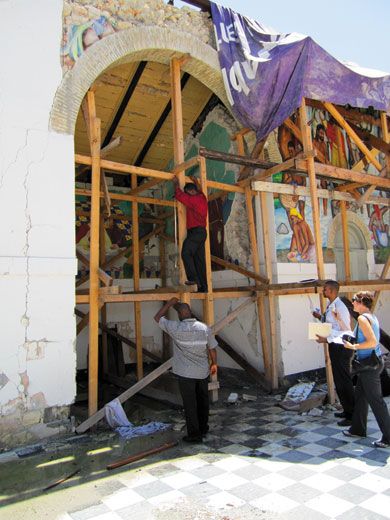Art Work
/https://tf-cmsv2-smithsonianmag-media.s3.amazonaws.com/filer/From-the-Castle-Haiti-conservation-631.jpg)
Singing Haitian children reminded me that even in the worst situations—earthquake recovery in Haiti will take decades—art and culture can help. I first heard the Haitian Boys Choir last July as it rehearsed among the rubble of Port-au-Prince’s Holy Trinity Cathedral; I heard the boys again in September when they performed here at the Smithsonian Institution. Eleven of Trinity Cathedral’s 14 magnificent murals were destroyed; I was there viewing three surviving murals, painted by Haitian master artists in the 1940s and 1950s and now protected by scaffolding.
Although Haiti is the Western Hemisphere’s poorest nation, it offers some of the Caribbean’s richest artistic and cultural traditions. But it was quickly apparent to me how many paintings and sculptures had been ripped or shattered. With the support of first lady Michelle Obama, the President’s Committee on the Arts and the Humanities and the State Department, Richard Kurin, the Smithsonian’s Under Secretary for History, Art and Culture, offered to help; the Haitian government welcomed the creation of the Haiti Cultural Recovery Project (haiti.si.edu).
Additional partners include the U.S. Committee of the Blue Shield, a nonprofit that protects cultural artifacts affected by armed conflict and disaster; the American Institute for Conservation, which trains and recruits conservators; the Institute of Museum and Library Services; the National Endowment for the Arts; the National Endowment for the Humanities; the Broadway League; the Hillman Foundation; the Haitian FOKAL foundation; UNESCO; and the International Centre for the Study of the Preservation and Restoration of Cultural Property.
The project leased a building in Port-au-Prince for conservation studios and climate-controlled storage. Former Smithsonian conservator Stephanie Hornbeck oversees the technical work. Olsen Jean Julien, a Haitian architect and former minister of culture who was a program coordinator for the Smithsonian Folklife Festival, is now the center’s manager. U.N. troops have provided engineering help and heavy equipment to carefully uncover buried artwork. By last summer’s end, the center was fully operational, treating 3,000 paintings, saving scores of pre-Columbian artifacts and historical documents and training dozens of Haitians. This spring we will share what we have learned with U.S. government agencies and professional organizations to help forge a more coordinated strategy for responding to future cultural crises. Meanwhile, the three murals are secure—and will be restored when the cathedral is rebuilt.
G. Wayne Clough is Secretary of the Smithsonian Institution.
/https://tf-cmsv2-smithsonianmag-media.s3.amazonaws.com/accounts/headshot/wayne-clough-240.png)

/https://tf-cmsv2-smithsonianmag-media.s3.amazonaws.com/accounts/headshot/wayne-clough-240.png)